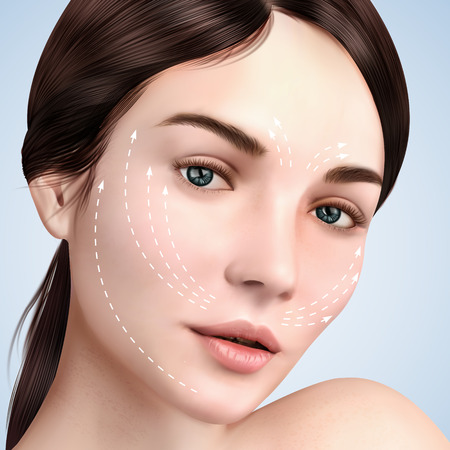Introduction to Aesthetic Procedures in the UK
Aesthetic procedures, often referred to as cosmetic treatments, have become increasingly prevalent across the United Kingdom. These interventions range from non-surgical options like Botox injections and dermal fillers to more involved treatments such as chemical peels, laser therapies, and minor surgical enhancements. The scope of what qualifies as an aesthetic procedure has expanded rapidly, now encompassing a wide variety of techniques aimed at enhancing one’s appearance without the need for major surgery. This rise in popularity is fuelled by evolving beauty standards, social media influence, and greater accessibility through high street clinics and private practices. As more Britons seek out these services, questions about safety and regulatory oversight have come to the fore. With an increasing number of providers entering the market—some with limited training or oversight—public concern has grown regarding potential health risks, variable outcomes, and consumer protection. Understanding how aesthetic procedures are defined, why they are so popular in the UK, and what makes their safety such a pressing issue is crucial for anyone considering treatment or working within the sector.
2. Understanding UK Regulatory Bodies
When considering the safety of aesthetic procedures in the UK, it is crucial to recognise the landscape of regulatory bodies that oversee this sector. The primary authorities are the Care Quality Commission (CQC) and the General Medical Council (GMC), each serving distinct roles in maintaining standards and protecting public safety.
CQC: Ensuring Safe Environments
The Care Quality Commission regulates health and social care services in England, including certain medical aesthetic treatments provided by clinics. The CQC focuses on ensuring that registered providers meet fundamental standards of quality and safety, particularly where treatments involve medical intervention or are conducted by healthcare professionals. Not all cosmetic procedures fall under CQC regulation—non-surgical treatments such as injectables may not always require registration, but clinics providing surgical interventions certainly do.
GMC: Professional Oversight for Doctors
The General Medical Council is responsible for regulating doctors in the UK. All medical practitioners offering aesthetic treatments must be registered with the GMC and adhere to its code of conduct. The GMC sets out professional standards, ethical guidelines, and has disciplinary powers should practitioners breach these expectations. For patients, verifying a practitioner’s GMC registration is an essential step before proceeding with any procedure.
Key Regulatory Bodies at a Glance
| Regulatory Body | Main Role | Scope in Aesthetics |
|---|---|---|
| Care Quality Commission (CQC) | Regulates clinical environments and ensures compliance with safety standards | Clinics providing surgical and some non-surgical procedures by healthcare professionals |
| General Medical Council (GMC) | Regulates doctors’ practice, professionalism, and training | Doctors performing aesthetic treatments |
Other Notable Organisations
In addition to the CQC and GMC, other organisations like the Nursing and Midwifery Council (NMC) and industry associations such as Save Face or the British Association of Aesthetic Plastic Surgeons (BAAPS) also contribute to upholding standards through registers, audits, and best practice guidance. While not all are statutory regulators, they play a significant role in promoting patient safety and transparency within the aesthetic sector.

3. Training and Qualifications for Practitioners
In the UK, the training and qualifications required for practitioners offering aesthetic procedures are subject to strict regulations designed to protect public safety. Not everyone is legally permitted to perform these treatments; specific education, certifications, and experience are essential prerequisites. For example, procedures involving injections—such as Botox or dermal fillers—must be administered by a registered healthcare professional, typically a doctor, dentist, nurse, or pharmacist prescriber with specialised training in aesthetics. These professionals must also be registered with relevant regulatory bodies such as the General Medical Council (GMC), Nursing and Midwifery Council (NMC), or General Dental Council (GDC).
The pathway to becoming a qualified aesthetic practitioner usually begins with an accredited degree in medicine, dentistry, or nursing. Following this, additional postgraduate training in aesthetic medicine is often pursued through certified courses recognised by organisations like the Joint Council for Cosmetic Practitioners (JCCP) or the British College of Aesthetic Medicine (BCAM). These courses cover both theoretical knowledge and practical skills, ensuring practitioners are well-versed in anatomy, complications management, and ethical considerations.
Furthermore, ongoing professional development is critical. Practitioners must regularly update their skills through continued education and hands-on workshops to stay abreast of new techniques and regulatory changes. It’s also important for them to carry adequate indemnity insurance and operate within a clinical environment that adheres to Care Quality Commission (CQC) standards if surgical or invasive procedures are performed. By ensuring these rigorous requirements are met, the UK aims to maintain high standards of safety and professionalism across all aesthetic practices.
4. Clinic Standards and Patient Safety
Ensuring the safety of aesthetic procedures in the UK hinges greatly on the standards upheld by clinics, their equipment, and protocols. The regulatory landscape is designed to safeguard patients from unnecessary risks by enforcing strict guidelines for facilities and practitioners. Understanding these measures can help patients make informed decisions about where to seek treatment.
Registered Clinics: Legal Requirements
In the UK, clinics offering aesthetic treatments such as Botox, dermal fillers, or laser therapies must be registered with relevant bodies like the Care Quality Commission (CQC) in England, Healthcare Improvement Scotland (HIS), or Healthcare Inspectorate Wales (HIW). Registration ensures that clinics comply with health and safety regulations, maintain proper records, and are subject to routine inspections.
| Nation | Regulatory Body | Scope of Oversight |
|---|---|---|
| England | CQC | Clinical governance, premises safety, practitioner qualifications |
| Scotland | HIS | Treatment protocols, infection control, patient consent |
| Wales | HIW | Facility hygiene, incident reporting, staff training |
Equipment Standards and Maintenance
Aesthetic procedures often use advanced devices such as lasers or injectables. UK regulations require that all equipment meets British Standards Institution (BSI) certification and is regularly maintained according to manufacturer specifications. This reduces the risk of device malfunction and ensures consistent results for patients.
Key Equipment Compliance Points:
- Certification: All medical devices must display a CE or UKCA mark.
- Maintenance Logs: Clinics must keep up-to-date service and repair records.
- User Training: Only trained personnel are permitted to operate specialist equipment.
Hygiene Protocols: Minimising Infection Risk
The prevention of infection is a cornerstone of patient safety. Registered clinics follow rigorous cleaning routines, sterilisation procedures for instruments, and use only single-use needles where appropriate. Staff are required to wear appropriate PPE (Personal Protective Equipment) during all procedures. Regular audits ensure compliance with national infection control standards set by Public Health England and local health authorities.
Typical Hygiene Checklist:
- Treatment rooms cleaned between each patient appointment
- Sterile packaging for consumables opened in front of patients
- Sharps disposal systems in place and regularly emptied
- PPE worn by all clinical staff at all times during procedures
Safeguarding Patient Wellbeing: Informed Consent & Aftercare
A fundamental part of clinic standards is ensuring patients are fully informed about their chosen procedure. This includes discussing potential risks, expected outcomes, and aftercare requirements. Written consent forms are standard practice. Post-procedure support is also provided—patients receive clear instructions on how to care for treated areas and know whom to contact in case of complications.
5. Consent, Aftercare, and Patient Rights
One of the most critical aspects of safety in UK aesthetic procedures is ensuring robust consent processes, comprehensive aftercare, and clear protection of patient rights. Informed consent is not just a formality—it is a legal and ethical requirement that ensures patients understand the risks, benefits, alternatives, and expected outcomes of any aesthetic treatment. Practitioners must provide information in plain English, answer all questions, and give clients adequate time to make decisions without pressure or misleading claims.
Informed Consent Procedures
Before any aesthetic procedure begins, practitioners are required to conduct a thorough consultation. This includes discussing medical history, assessing suitability for treatment, and explaining exactly what the procedure entails. Patients should be made aware of potential side effects and complications, as well as realistic expectations for results. Written consent forms are standard practice across the UK, but verbal confirmation and ongoing dialogue are equally important components. Regulatory bodies such as the Care Quality Commission (CQC) emphasise transparency and honesty at every stage.
What Aftercare Involves
Aftercare is another vital part of patient safety in aesthetic treatments. Good clinics will provide clear written instructions on post-treatment care—ranging from advice about wound cleaning to recommendations for avoiding sun exposure or strenuous exercise. Follow-up appointments are often scheduled to monitor healing and address any concerns promptly. UK practitioners are also expected to offer accessible channels for patients to report adverse reactions or seek further guidance if needed.
Patient Rights in the UK
The rights of patients undergoing aesthetic procedures are protected by multiple layers of regulation and professional codes of conduct. Patients have the right to receive honest information about their practitioner’s qualifications, the products used, and any associated risks. They are entitled to privacy regarding their medical data and freedom from discrimination or undue influence during decision-making. Should anything go wrong, patients have recourse through formal complaint procedures—both within clinics and via independent regulators such as the General Medical Council (GMC) or CQC.
Summary: Putting Patients First
The UK’s approach to aesthetic procedures places a strong emphasis on protecting individuals’ autonomy and wellbeing throughout their treatment journey. By prioritising informed consent, diligent aftercare, and safeguarding patient rights, the system aims to foster trust between practitioners and clients while maintaining high standards of safety and professionalism.
6. Reporting and Handling Adverse Events
Despite strict regulations and standards in the UK, complications and adverse reactions can still occur following aesthetic procedures. It is crucial for both practitioners and patients to understand the correct protocols for reporting and managing such incidents. If you experience an unexpected reaction or are dissatisfied with your results, your first step should be to contact your practitioner directly. Reputable clinics will have clear complaints procedures and should respond promptly to any concerns.
If you feel your complaint has not been handled appropriately, you can escalate the issue. The Care Quality Commission (CQC) oversees certain regulated activities in England and accepts concerns about registered providers. For non-surgical cosmetic procedures, professional bodies such as the General Medical Council (GMC), Nursing and Midwifery Council (NMC), or the Joint Council for Cosmetic Practitioners (JCCP) can investigate complaints regarding malpractice or breaches of conduct. In Scotland, Healthcare Improvement Scotland serves a similar regulatory function.
Reporting adverse events is also vital for improving safety standards across the industry. The Yellow Card Scheme, run by the Medicines and Healthcare products Regulatory Agency (MHRA), allows both practitioners and patients to report suspected side effects from medicines, medical devices, or cosmetic products. This helps authorities monitor product safety and take appropriate action if necessary.
If harm has occurred due to negligence or poor practice, legal recourse may be available through civil claims. Seeking advice from a solicitor specialising in medical negligence can clarify your options. Additionally, professional indemnity insurance held by reputable practitioners ensures that patients are protected should something go wrong.
Ultimately, transparent reporting systems and strong regulatory oversight are designed to protect individuals seeking aesthetic treatments in the UK. By knowing how to raise concerns and understanding the available support mechanisms, patients contribute to a safer environment for all.


